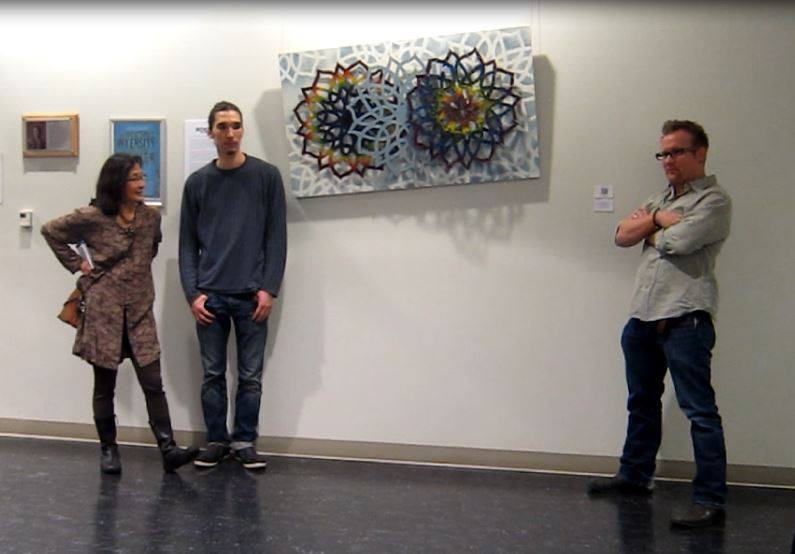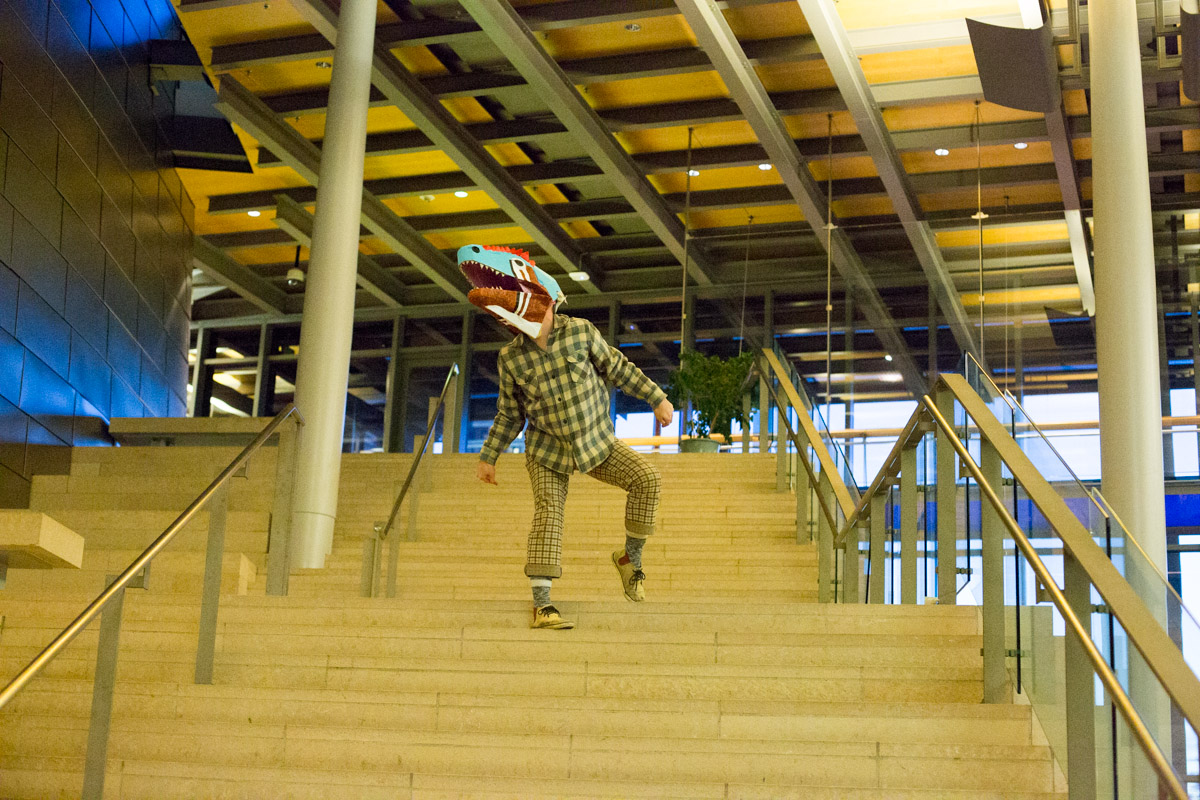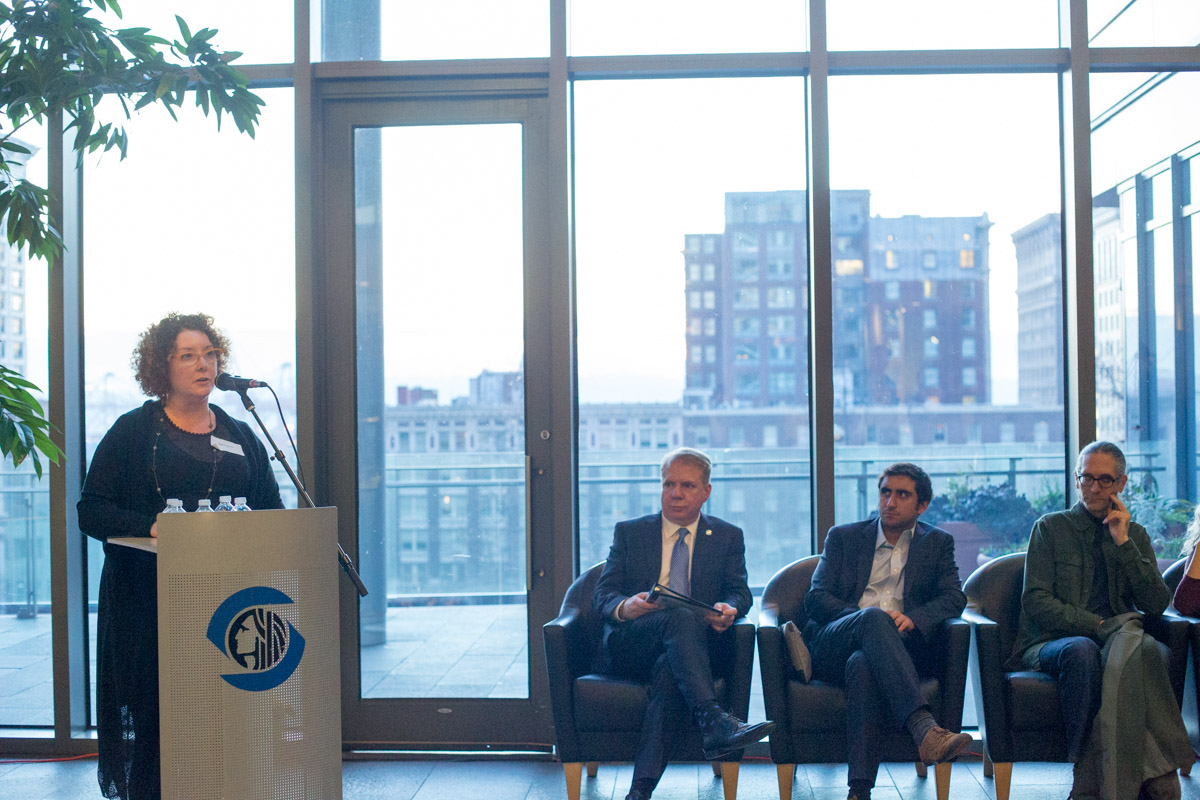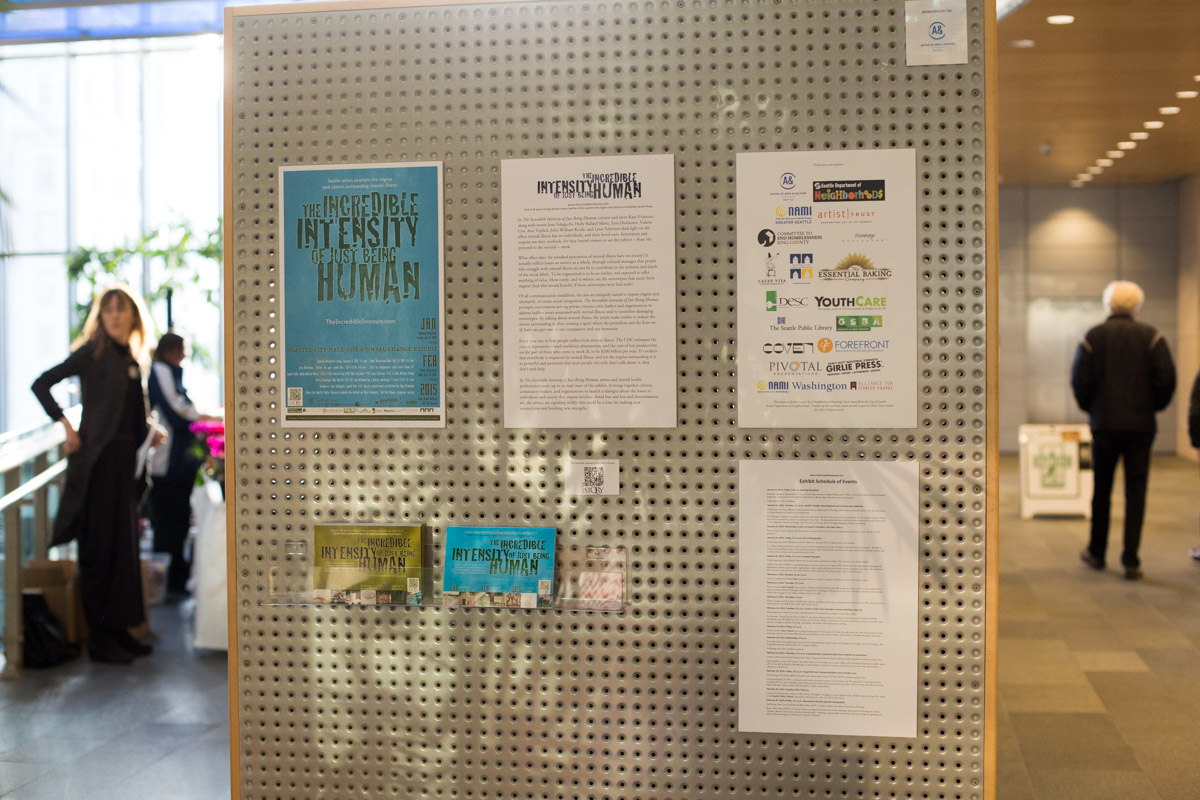Omphaloskepsis Blog
The Politics of the Social: How I Created Social Practice Art Masquerading As an Exhibit
Jan 18, 2015
The Incredible Intensity of Just Being Human: Exhibit As Social Practice Art

[Above: volunteers, visitors, artists and esteemed guests. Nearly 200 people gather for the exhibit opening. Photo credit: Mark Laubenheimer]
Exquisite Discomfort
It has been my great honor to create this exhibit. The audience and the artists have been my medium. It was immensely powerful for me to hear one artist speak the words, "my daughter has mental illness. I never said those words out loud before." And to work with another artist who declared at the beginning of the process: "We will not be naming the mental illness, we have succumbed to the stigma and the silence. That's the way it has to be if I'm going to protect my family." By the time the lunch hour talks have begun she and her child are standing in front of a public audience, sharing their story together, "my artwork is a love letter to my son."┬Ā

┬Ā[Artist June Sekiguchi, Quin Breeland, and Eli Hastings give a public talk in the Anne Focke Gallery Jan 2015. Photo credit: June Sekiguchi]
This two-month long act of social art masquerades as an exhibit. Social practice art is an art form many are not familiar with. Social practice art is art that brings people together, illuminating their interdependence and highlighting the hidden relationship of people who appear non-relational. It tends to be political, and has its origins in Marxist theory:┬Āthe reciprocal and all-sided dependence of the very individuals who are indifferent to one another is precisely what forms their social connection. Thus, social practice art reveals the interdependence of┬Āpeople who thought of themselves as independent, or even alienated, from one another. (Shannon Jackson, Tate Modern, The Politics of the Social in Contemporary Art, 2013)
Below are excerpts from my curatorial statement available in our exhibit catalog. The catalog, named after the artwork and exhibit, is available on lulu.com
The Art of the Social
Artists, mental health professionals, and advocates for mental health co-lead tours of The Incredible Intensity of Just Being Human. Civic leaders step up to share the platform and join the conversation. My hope, as the curator and as a participating artist, is that viewers ŌĆō stakeholders in the body politic ŌĆō will be ready to participate, as well.
Are you ready?
Being ready, in this context, means being willing to involve yourself in a burgeoning art form new to many. Social practice art is art that brings people together. Speaking at a conference for the Tate Modern in 2013, Shannon Jackson, in┬ĀSocial Turns: in Theory and Across the Arts, made the point that social practice art illuminates viewersŌĆÖ interdependence and highlights the hidden relationship of people who appear non-relational. ItŌĆÖs often political, and has its origins in Marxist theory:┬Āthe reciprocal and all-sided dependence of the very individuals who are indifferent to one another is precisely what forms their social connection.
Thus, social practice art reveals the interdependence of┬Āpeople who thought of themselves as independent, or even alienated, from one another. Its aesthetics are not beauty, but discomfort, antagonism and opposition.

[Above: Key note speaker, former King County Executive Randy Revelle, Mayor Ed Murray, not pictured: Representatives Tina Orwall and Brady Walkinshaw, Executive Director of the Office of Arts and Culture Randy Engstrom, Executive Director of Department of Neighborhoods Bernie Agor Matsuno. Photo credit: Mark Laubenheimer]
The Act of Othering
Art connects us. It tells us weŌĆÖre human, weŌĆÖre like one another, we feel the same emotions. My mission as a human being, and my job as an artist, is to use art to create deep connections among us. Those deep connections already exist, but sometimes convention rewards us for ignoring them. The greater rewards, however, come from exploring them, and, as the curator of the art and social change exhibition, The Incredible Intensity of Just Being Human, my intent is to launch a dialogue about the losses inflicted by stigma, not only on individuals who are stigmatized, but on society.
What stigma is that? ItŌĆÖs a subject that I, and the other participating artists, know well.

[Above: Ezra Dickinson performs Mother for you I made this at the opening reception. Photo credit: Mark Laubenheimer]
The Incredible Intensity of Just Being Human┬Ābrings together citizens, artists, community leaders, and community-based organizations, to examine what might happen if stigma were set aside.┬ĀThat is, if artifacted and unnecessary barriers between people were overturned, in favor of many fewer assumptions and prejudices. Who is mentally healthy, after all, and who is not? And, according to whom?
Well-being, in the usual sense, is a point on a continuum. Who among us is so firmly anchored at just that point that we can ŌĆ£otherŌĆØ people who seem too far away? Perhaps the very act of othering the mentally ill is superstitious, not rational. Perhaps we other people mainly to make ourselves feel safer from the most frightening, life-altering ills we can witness or imagine. What if we opted to be braver and less judgmental than that? To walk into the incredible intensity of just being human to find gifts, not fears or failures?
Artists embed deep metaphors in their work to reference mental anguish, disorganization, and disease.┬ĀPeople are so entrenched in their metaphors as to be disconnected from them, literally not seeing the forest for the trees.┬ĀWhat would happen if we no longer had to speak in code and metaphor?┬ĀWould an entire way of communicating be lost? And what would fill that void?┬Ā

[Above: volunteeers serve food at the opening reception. From the volunteers, to the food, to the sponsors, speakers, and artists, the entire exhibit was carefully choreographed. Photo credit: Mark Laubenheimer]
It's Incredibly Intense to Be Human
The late art critic Robert Hughes observed, ŌĆ£Art teaches us something about the world we live in.ŌĆØ We are all human beings having a human experience. ItŌĆÖs intense, incredibly intense. If art must teach us something about the world we live in, then perhaps it teaches us to reach out to others, that to dig deeper reaps rewards, and that we share the human condition. To share is the antithesis of labeling, and the path to overturning stigma. ŌĆ£Nothing human is alien to me,ŌĆØ as Goethe remarked.
Bibliography
The Incredible Intensity of Just Being Human, Exhibit Catalog, Kate Vrijmoet, David Francis, Gayle Clemans, Grace Boey
Randy Revelle's talk on Overcoming the Stigma of Mental Illness: Randy_Revelle_OVERCOMING_THE_STIGMA-final.docx
Jackson, Shannon. Social Turns: in Theory and Across the Arts. Tate Modern: Starr Auditorium, Friday, 15 February 2013. The politics of the social in contemporary art, conference.
Lamb, Jennifer. Creating Change: Using the Arts to Help Stop the Stigma of Mental Illness and Foster Social Integration. Journal of Holistic Nursing. 28 January 2009.
Sponsors
Alliance for Pioneer Square
Allied Arts Foundation
Caffe Vita Coffee Roasting Company
CEHKC (Committee to End Homelessness Kind County)
Coven Salon
DESC (Downtown Emergency Services Commission)
Essential Baking Company
Forefront
Girlie Press, Inc.
Hommage Restaurant
GSBA (Greater Seattle Business Association)
NAMI-Greater Seattle (National Alliance for Mental Illness)
NAMI-Washington
PCC Natural Markets
Pivotal Presentations
Seattle/King County Coalition on Homelessness
Seattle Public Library
YouthCare
Disclaimers
This project is funded in part by a Neighborhood Matching Fund award from the City of Seattle, Seattle Department of Neighborhoods.
Creation of this work was made possible in part by Artist Trust Grants for Artist Projects award.




┬Ā
 MENU
MENU
